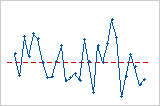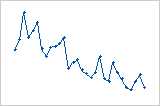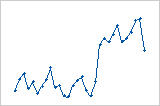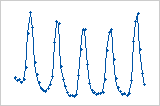In This Topic
Step 1: Determine whether the association between the response and term is statistically significant
- P-value ≤ α: The association is statistically significant
- If the p-value is less than or equal to the significance level, you can conclude that there is a statistically significant association between the response variable and the term.
- P-value > α: The association is not statistically significant
- If the p-value is greater than the significance level, you cannot conclude that there is a statistically significant association between the response variable and the term. You may want to refit the model without the term.
Minitab does not display p-values for the linear terms of the components in mixtures experiments because of the dependence between the components. Specifically, because the components must sum to a fixed amount or to a total proportion of 1, changing a single component forces a change in the others. Additionally, the model for a mixtures experiment does not include a constant because it is incorporated into the linear terms.
- Interaction terms that include only components indicate that the association between the blend of components and the response is statistically significant.
- Positive coefficients for interaction terms indicate that the components in the term act synergistically. That is, the mean response value is greater than the value you would obtain by calculating the simple mean of the response variable for each pure mixture.
- Negative coefficients for interaction terms indicate that the components in the mixture act antagonistically. That is, the mean response value is less than the value you would obtain by calculating the simple mean of the response variable for each pure mixture.
- Interaction terms that include components and the process variables indicate that the effect of the components on the response variable depends on the process variables.
Tip
To further explore the relationships of the components and the process variables with the response, use Contour Plot, Surface Plot and Response Trace Plot.
Estimated Regression Coefficients for Flavor (component proportions)
| Term | Coef | SE Coef | T-Value | P-Value | VIF |
|---|---|---|---|---|---|
| Emmenthaler | 104.874 | 0.667 | * | * | 15.94 |
| Gruyere | 175.08 | 5.89 | * | * | 203.46 |
| Broth | -8.810 | 0.659 | * | * | 26.04 |
| Emmenthaler*Gruyere | 59.2 | 10.3 | 5.75 | 0.000 | 57.33 |
| Gruyere*Broth | 30.04 | 9.00 | 3.34 | 0.008 | 109.44 |
| Emmenthaler*Temperature | 4.500 | 0.475 | 9.48 | 0.000 | 8.09 |
| Gruyere*Temperature | 4.500 | 0.679 | 6.62 | 0.000 | 2.71 |
| Broth*Temperature | 4.500 | 0.443 | 10.16 | 0.000 | 11.76 |
Key Results: P-Value, Coefficients
All of the interaction terms have p-values that are less than the significance level of 0.05.
The positive coefficients for the interaction terms with two components indicate that the two component blends act synergistically. The mean flavor score for each blend is greater than you would obtain by calculating the simple mean of the two flavor scores for each pure mixture.
Additionally, the interaction between the ingredients and the process variable, temperature, indicate that the flavor score of the mixture depends on the serving temperature.
Step 2: Determine how well the model fits your data
To determine how well the model fits your data, examine the goodness-of-fit statistics in the Model Summary table.
- S
-
Use S to assess how well the model describes the response. Use S instead of the R2 statistics to compare the fit of models that have no constant.
S is measured in the units of the response variable and represents how far the data values fall from the fitted values. The lower the value of S, the better the model describes the response. However, a low S value by itself does not indicate that the model meets the model assumptions. You should check the residual plots to verify the assumptions.
- R-sq
-
The higher the R2 value, the better the model fits your data. R2 is always between 0% and 100%.
R2 always increases when you add additional predictors to a model. For example, the best five-predictor model will always have an R2 that is at least as high as the best four-predictor model. Therefore, R2 is most useful when you compare models of the same size.
- R-sq (adj)
-
Use adjusted R2 when you want to compare models that have different numbers of predictors. R2 always increases when you add a predictor to the model, even when there is no real improvement to the model. The adjusted R2 value incorporates the number of predictors in the model to help you choose the correct model.
- R-sq (pred)
-
Use predicted R2 to determine how well your model predicts the response for new observations. Models that have larger predicted R2 values have better predictive ability.
A predicted R2 that is substantially less than R2 may indicate that the model is over-fit. An over-fit model occurs when you add terms for effects that are not important in the population. The model becomes tailored to the sample data and, therefore, may not be useful for making predictions about the population.
Predicted R2 can also be more useful than adjusted R2 for comparing models because it is calculated with observations that are not included in the model calculation.
- Small samples do not provide a precise estimate of the strength of the relationship between the response and predictors. If you need R2 to be more precise, you should use a larger sample (typically, 40 or more).
- R2 is just one measure of how well the model fits the data. Even when a model has a high R2, you should check the residual plots to verify that the model meets the model assumptions.
Model Summary
| S | R-sq | R-sq(adj) | PRESS | R-sq(pred) |
|---|---|---|---|---|
| 0.276960 | 99.98% | 99.97% | 2.65322 | 99.93% |
Key Results: S, R-sq, R-sq (adj), R-sq (pred)
In these results, the model explains 99.98% of the variation in the flavor score. For these data, the R2 value indicates the model provides a good fit to the data. If additional models are fit with different predictors, use the adjusted R2 values and the predicted R2 values to compare how well the models fit the data.
Step 3: Determine whether your model meets the assumptions of the analysis
Use the residual plots to help you determine whether the model is adequate and meets the assumptions of the analysis. If the assumptions are not met, the model may not fit the data well and you should use caution when you interpret the results.
For more information on how to handle patterns in the residual plots, go to Residual plots for Analyze Mixture Design and click the name of the residual plot in the list at the top of the page.
Residuals versus fits plot
The patterns in the following table may indicate that the model does not meet the model assumptions.| Pattern | What the pattern may indicate |
|---|---|
| Fanning or uneven spreading of residuals across fitted values | Nonconstant variance |
| Curvilinear | A missing higher-order term |
| A point that is far away from zero | An outlier |
| A point that is far away from the other points in the x-direction | An influential point |
Use the residuals versus fits plot to verify the assumption that the residuals are randomly distributed and have constant variance. Ideally, the points should fall randomly on both sides of 0, with no recognizable patterns in the points.
Residuals versus order plot


Trend

Shift

Cycle
Normal probability plot of the residuals
Use the normal probability plot of the residuals to verify the assumption that the residuals are normally distributed. The normal probability plot of the residuals should approximately follow a straight line.
The patterns in the following table may indicate that the model does not meet the model assumptions.
| Pattern | What the pattern may indicate |
|---|---|
| Not a straight line | Nonnormality |
| A point that is far away from the line | An outlier |
| Changing slope | An unidentified variable |
